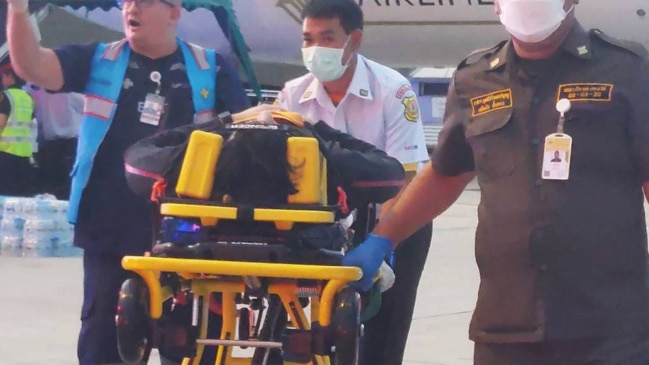Kerry Jordan, who was severely injured when Singapore Airlines flight 321 struck turbulence has spoke of the experience
The Adelaide woman left paralysed from the chest down after her traumatic Singapore Airlines flight 321 has spoken of the experience.

SA News
Don't miss out on the headlines from SA News. Followed categories will be added to My News.
Kerry Jordan, who was severely injured when Singapore Airlines flight 321 struck turbulence on a flight from London, is paralysed from the chest down and unlikely to ever walk again.
Speaking from Royal Adelaide Hospital, Ms Jordan said she had been trying to reattach her seatbelt after a trip to the bathroom when the turbulence hit with no warning.
“I came back to my seat and was sitting down, and I could not put my seatbelt on,’’ Ms Jordan said.
“Literally everything just started shaking so much, I could not get to my seatbelt to put it back.
“All I remember was being up in the air and everything was absolutely silent and then I was on the floor.
“Probably the best way to describe it was absolutely violent. I think that the shock for me as well was that when it all happened, within 10 seconds of me trying to get my seatbelt, back on.’’

Mrs Jordan was sitting in seat 44D for the flight. Her husband Keith Davis was next to her in 44E.
Mr Davis was also not wearing his seatbelt when the turbulence hit and suffered a shoulder injury and blurred vision.
He said he did not know if his wife was alive or dead when she hit the floor.
“When she hit the ground, she never moved and that was so unnatural, and I was just horrified,’’ he said.
“Obviously, when you hit that hard and uncomfortable, you react. Kerry had no reaction. There was a moment there I didn’teven know she was alive.’’
Ms Jordan, a dance teacher at Mitcham Girls High School and part of the team at Adelaide’s award-winning Restless Dance Theatre, remembers another passenger asked if she could move her legs.
“I just tried to. I already had tried to earlier, and I couldn’t,’’ she remembered. “And then I just remember him saying, potential spinal injury.’’
Ms Jordan remained on the floor for the remainder of the flight and was then moved to intensive care at a Bangkok hospital.

She was one of dozens who were injured when SQ321 from London to Singapore on May 21 hit turbulence over Myanmar. A 73-year-old British man died from a suspected heart attack.
Ms Jordan was medically evacuated from Bangkok and is now in the spinal unit at the RAH. From there the 52-year-old faces months of rehabilitation at the Daw Park spinal unit.
The break in her spine is at the C7-T1 segment which connects the neck with the upper back.
Ms Jordan also suffered fractures of the C1 and C2 veterbrae at the top of the spine, as well as fractured ribs and a brain bleed.
Ms Jordan can feel “nothing from basically the chest down’, can move her arms, but is unable to use her hands.
“The basic things, obviously of not being able to feed myself, or brush my own teeth, or try and change the channel on the TV, or using my mobile phone is out of the question,’’ she said.

“I think that’s the hardest, not being able to feel most of my body.’’
The couple had been returning from an “absolutely magical holiday’’ through Ireland, Scotland, and Wales when the accident happened.
Mr Davis, a landscape architect, said the care in the RAH had been excellent and he had nothing but admiration for the way his wife had coped.
“I come in here each day and I’m just absolutely amazed with Kerry’s attitude and strength,’’ he said.
“It’s just inspiring. I don’t know how she wakes up every day and just gets on with it.’’ Ms Jordan’s students at Mitcham Girls High School were among the first people she thought of when she landed in Bangkok.
Lawyer and former senator Nick Xenophon said the couple were now examining their legal options for the injuries incurred on the Singapore Airlines flight.
Mr Xenophon said he was the Australian lawyer on what was an international team that included US-based aviation lawyer Floyd Wisner.

Mr Wisner has previously represented families who lost loved ones when Boeing 737 Max-8 aircraft crashed in Indonesia and Ethiopia.
“This is very much the investigation stage and no stone will be left unturned to get to the truth of what actually happened,’’ Mr Xenophon said.
“This incident will have widespread ramifications in terms of airlines doing everything possible to avoid death and serious injury.’’
Mr Wisner said “the area where this incident occurred is renowned as one of the worst areas for turbulence in the world’’.
Originally published as Kerry Jordan, who was severely injured when Singapore Airlines flight 321 struck turbulence has spoke of the experience






